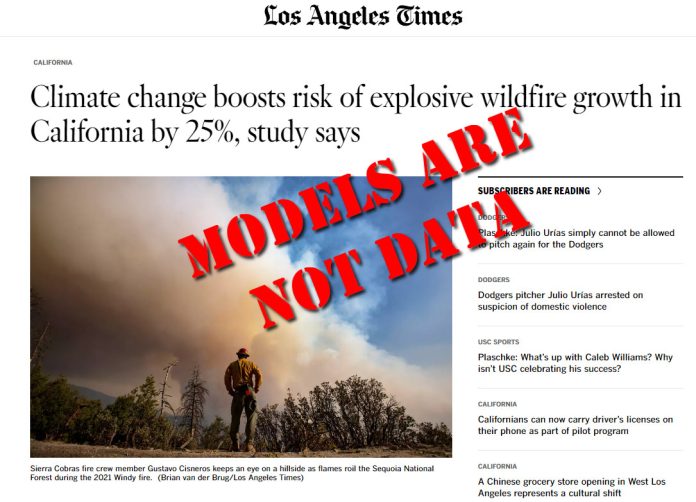An article in The Los Angeles Times (LA Times) published on September 4, 2023 makes the claim that a study by a Berkeley think tank proves “Climate change has ratcheted up the risk of explosive wildfire growth in California by 25%.” This is false. The study ignores other more important factors, and real-world data shows the moisture in the regions of California most affected by wildfires has actually increased, rather than decreased as the study claims.
The LA Times cites a Nature study titled “Climate warming increases extreme daily wildfire growth risk in California.” In the abstract of the paper the authors make an important admission: “Some portion of the change in wildfire behavior is attributable to anthropogenic climate warming, but formally quantifying this contribution is difficult because of numerous confounding factors and because wildfires are below the grid scale of global climate models.”
They also say: “We find that the influence of anthropogenic warming on the risk of extreme daily wildfire growth varies appreciably on a fire-by-fire and day-by-day basis, depending on whether or not climate warming pushes conditions over certain thresholds of aridity, such as 1.5 kPa of vapor-pressure deficit and 10% dead fuel moisture.”
The study fails on these two points because later in the study they cite global climate models using Artificial Intelligence (AI) to tease out relationships that can’t be accounted for in the grid-scale climate models to produce predictions. Models, and especially AI enhanced results are not actual data – they are projections based on the assumptions built into the models and the AI.
The models fail to account for the myriad confounding factors the authors themselves previously acknowledged, such as the increase in arson caused wildfires. In fact, the word “arson” is not mentioned anywhere in the study nor is there any detailed discussion of the actual contributions to increased wildfires of the so-called “confounding factors” in the study.
Ironically, the answer lies in an LA Times article from 2021 which stated: “Electrical equipment accounted for about 12% and lightning 6%. But arson was also a factor, sparking about 9% of fires in 2019, and roughly 8% to 10% of the state’s wildfires in any given year.”
The authors also ignored a 2017 study in the Proceedings of the National Academy of Science (PNAS) which looked at actual data instead of computer models and concluded that in the United States, humans accounted for 84% of wildfires:
Our analysis of two decades of government agency wildfire records highlights the fundamental role of human ignitions. Human-started wildfires accounted for 84% of all wildfires, tripled the length of the fire season, dominated an area seven times greater than that affected by lightning fires, and were responsible for nearly half of all area burned.
A second problematic aspect of the study relates to their use of, “vapor-pressure deficit and 10% dead fuel moisture.” Leaving aside the study’s use of AI enhanced modeling to sift for correlations between small scale moisture changes and wildfire, the researchers also used a novel and little-known approach to link the so-called drought and heat to fossil fuel emissions: Vapor Pressure Deficit (VPD). The VPD is similar to, but not the same as, the more commonly known relative humidity seen in daily weather reports. In layman’s terms, VPD measures how much water is in the air versus the maximum amount of water vapor that can exist in that air. This atmospheric metric is hardly ever used. Climate Realism has refuted the use of VPD to understand drought and wildfire previously.
Most egregious of all, the Nature study itself ignored actual published data about VPD drying. The 2020 paper, Plant responses to rising vapor pressure deficit, examines actual data for the western U.S., specifically in the mountains of California, and shows VPD has decreased, indicating more moisture. These areas show VPD values that indicate more moisture, rather than less, and completely contradict the claims of drying made in the Nature study. This is seen in Figure 1 below, with both the U.S. and an expanded magnified panel showing the western area of the study. The green colors indicate wetter conditions.

Not only are the authors of the Nature study ignoring the easily available and contradictory VPD evidence in their paper, but they also used global scale climate models to support their assertion that climate change induced VPD deficits are driving wildfires in California, while at the same time admitting the models aren’t suitable for purpose at that scale. Instead, they use AI to tease out fire projections they believe are there but really aren’t.
This is a classic example of the overreliance on models (and now AI) in climate research, instead of actual data. Models are not data, nor do they define reality as actual data does. It is shameful that science and the LA Times present model outputs as such.

















